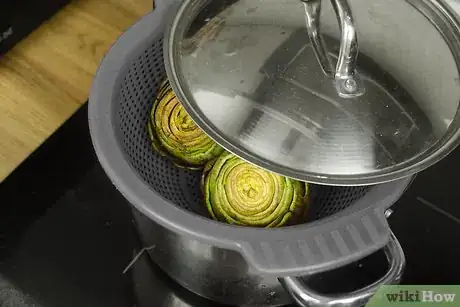This article was co-authored by wikiHow Staff. Our trained team of editors and researchers validate articles for accuracy and comprehensiveness. wikiHow's Content Management Team carefully monitors the work from our editorial staff to ensure that each article is backed by trusted research and meets our high quality standards.
The wikiHow Video Team also followed the article's instructions and verified that they work.
This article has been viewed 503,200 times.
Learn more...
Artichokes are absolutely delicious, but you may be wondering just how in the world you cook them. With their tough, spiky leaves, they can seem like an intimidating vegetable to prepare. But they’re actually really easy! The key is to choose fresh artichokes and properly prepare them. After that, cooking is easy. To help you out, we’ve put together a handy list of things you can do to make cooking your artichokes a breeze.
Steps
Artichoke Recipes
Community Q&A
Did you know you can get answers researched by wikiHow Staff?
Unlock staff-researched answers by supporting wikiHow
-
QuestionWhy do artichokes make drinks taste sweet?
 wikiHow Staff EditorThis answer was written by one of our trained team of researchers who validated it for accuracy and comprehensiveness.
wikiHow Staff EditorThis answer was written by one of our trained team of researchers who validated it for accuracy and comprehensiveness.
Staff Answer wikiHow Staff EditorStaff AnswerArtichokes contain, among others, the compounds potassium salts of chlorogenic acids and cynarin, which are believed to contribute to this effect. Cynarin has been shown by scientific studies to have a perceived effect on drinks such as water equivalent to adding 2 teaspoons of sugar to 170ml of water. While this effect doesn't affect all people, a large amount of people can detect the sweetening effect after consuming artichokes. Likely it's a combination of both genetic responsiveness to the compounds and interaction of the just the right amount and types of compounds in the artichokes!
wikiHow Staff EditorStaff AnswerArtichokes contain, among others, the compounds potassium salts of chlorogenic acids and cynarin, which are believed to contribute to this effect. Cynarin has been shown by scientific studies to have a perceived effect on drinks such as water equivalent to adding 2 teaspoons of sugar to 170ml of water. While this effect doesn't affect all people, a large amount of people can detect the sweetening effect after consuming artichokes. Likely it's a combination of both genetic responsiveness to the compounds and interaction of the just the right amount and types of compounds in the artichokes! -
QuestionWhat does artichoke taste like?
 wikiHow Staff EditorThis answer was written by one of our trained team of researchers who validated it for accuracy and comprehensiveness.
wikiHow Staff EditorThis answer was written by one of our trained team of researchers who validated it for accuracy and comprehensiveness.
Staff Answer wikiHow Staff EditorStaff Answer
wikiHow Staff EditorStaff Answer -
QuestionCan you grow your own artichokes at home?
 wikiHow Staff EditorThis answer was written by one of our trained team of researchers who validated it for accuracy and comprehensiveness.
wikiHow Staff EditorThis answer was written by one of our trained team of researchers who validated it for accuracy and comprehensiveness.
Staff Answer wikiHow Staff EditorStaff AnswerYes, this is absolutely doable at home! If you live where the climate gets cold over winter, you'll need to grow them as annuals but it's possible to grow artichokes as perennials (long-term) if your winter climate is mild or warm. For helpful step-by-step tips, check out the wikiHow: How to Grow Artichokes. Growing them at home will let you have the freshest produce for home cooking.
wikiHow Staff EditorStaff AnswerYes, this is absolutely doable at home! If you live where the climate gets cold over winter, you'll need to grow them as annuals but it's possible to grow artichokes as perennials (long-term) if your winter climate is mild or warm. For helpful step-by-step tips, check out the wikiHow: How to Grow Artichokes. Growing them at home will let you have the freshest produce for home cooking.
Warnings
- The tough, fibrous parts of the artichoke’s leaves and the choke aren’t edible and could be a choking hazard for young children.[11]⧼thumbs_response⧽
References
- ↑ https://www.simplyrecipes.com/recipes/how_to_cook_and_eat_an_artichoke/
- ↑ https://www.thekitchn.com/how-to-cook-artichokes-22943703
- ↑ https://www.thekitchn.com/how-to-cook-artichokes-22943703
- ↑ https://www.thekitchn.com/how-to-cook-artichokes-22943703
- ↑ https://www.bhg.com/recipes/how-to/cook-with-fruits-and-vegetables/how-to-cook-artichokes/
- ↑ https://www.simplyrecipes.com/recipes/how_to_cook_and_eat_an_artichoke/
- ↑ https://www.bhg.com/recipes/how-to/cook-with-fruits-and-vegetables/how-to-cook-artichokes/
- ↑ https://www.bhg.com/recipes/how-to/cook-with-fruits-and-vegetables/how-to-cook-artichokes/
- ↑ https://www.simplyrecipes.com/recipes/how_to_cook_and_eat_an_artichoke/
About This Article
To cook artichokes, start by bringing a pot of water to a boil and removing the stems and tough leaves on some artichokes. Then, add the artichokes to the water and let it come to a boil again. Finally, cover the pot with 2 heavy plates and simmer the artichokes over medium-low heat for 20 minutes. You can also microwave artichokes if you're in a rush. Just remove the stems and tough leaves, cover the artichokes in a dish filled with 1/2 cup of water, and microwave them on high for 8-9 minutes. To learn how to steam and roast artichokes, scroll down!



























































